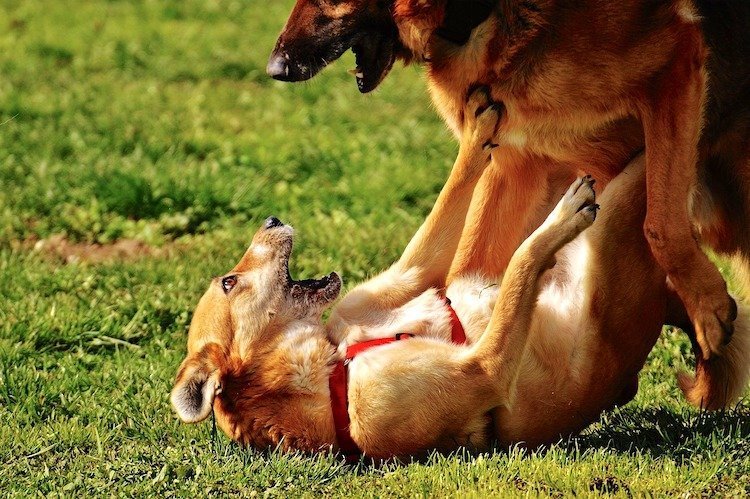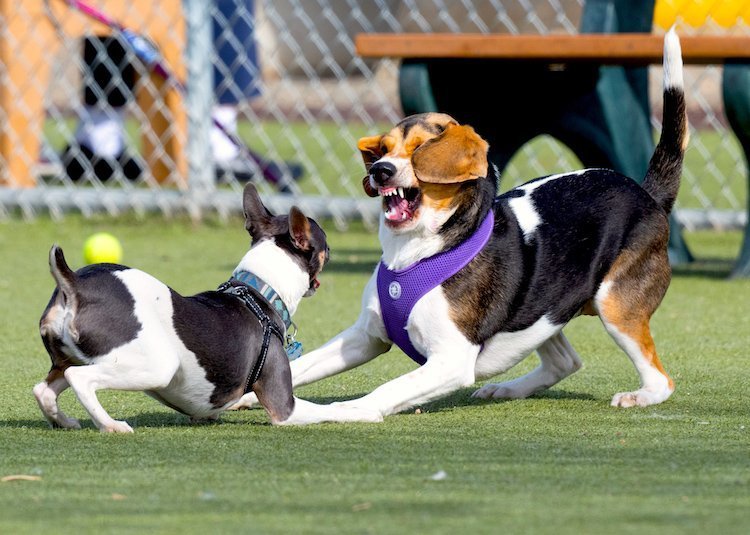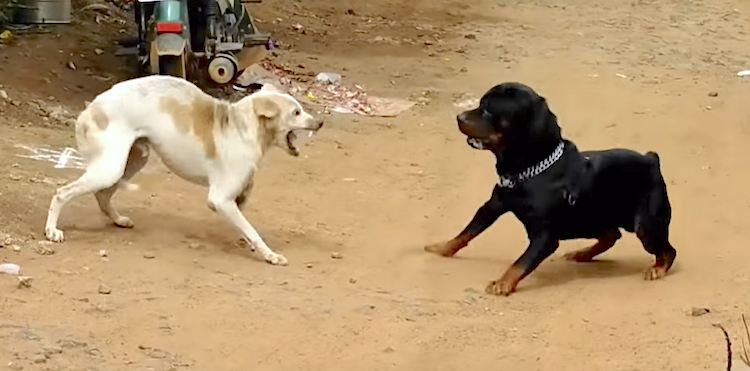How To Know When Dogs Are Playing

Years ago, my Edge Collie, Mack, was enjoying a game of chase with a group of dogs at the park.
The dogs all looked like they were having fun racing around the surface area.
A medium-sized white dog was just ahead of Mack, who and then turned and bumped into the white dog. The dog became furious and started lunging at and chasing Mack downwardly, intent on doing harm.
Mack spotted me and headed back toward me with the white dog on his tail. When he arrived, I was able to continue him out of damage's style long enough for the other dog's person to grab the dog and atomic number 82 them away.
What had started every bit a fun game quickly turned into a fight when a domestic dog who already had little impulse command was angered during a playful game.
Equally someone who is effectually dogs a lot — whether it'south my ain dogs, dogs I work with equally a professional dog trainer in Georgia or unknown dogs in public locations — I accept seen my fair share of fights and potential fights in the years since then.
Unfortunately, not all dog fights end every bit easily or quickly as that first feel did. But there are many things yous can do to prevent dog fights, cease them one time they have begun and learn how to spot potential trouble early on.
If you accept more than one dog or oft go places to permit your pup play with other dogs, you lot've probably wondered whether the dogs were fighting or playing. It tin be scary watching your canis familiaris get rough with another dog, and yous may non know if you should intervene or non.
In this expert guide to telling the divergence between dogs fighting or playing, we'll discuss:
- What do dogs wait like while playing?
- What do dogs expect like if they're really fighting?
- When play turns into existent fighting
- How to forbid dog fights
- How to finish dog fights
What Do Dogs Look Like While Playing?
According to researchers Barbara Smuts, PhD, and Camille Ward PhD, writing for The Bark, "Play fighting is the chief method [that dogs employ] to negotiate new relationships and develop lasting friendships."
"Although play is fun," they point out, "it also offers serious opportunities to communicate with another dog. In this sense, play is a kind of language."
Normal dog play tin can include barking, growling, tackling, stalking, chasing, biting, whining and wrestling.
But … fights can as well include whatsoever of those things, too.
So, how exercise yous tell the departure?
Your domestic dog may be barking and growling, but expect at your domestic dog's face and overall body language. In most cases, a playful canis familiaris will have different body language than a dog who wants to fight.

Play behavior typically includes:
- A play bow right earlier an "attack": A play bow is where a dog's front end is lowered to the footing while their backend stays upright. Information technology looks similar the dog is taking a bow.
- Open, loose-mouthed smile.
- Relaxed ears: Other ear postures can hateful either playing or fighting, depending on what the remainder of the dog's body language is communicating.
- Loose, fluid, wagging tail: A strong, quick tail wag can exist a sign of danger, though. Pay attending to whether the tail looks relaxed. (If either domestic dog has a short tail, do non utilize the tail as an indicator.)
- The dogs are taking turns chasing each other or existence on the bottom while wrestling.
- When one dog seems tired, the other dog allows them to take a break.
- If they are biting each other, the bites are very gentle and leave no marks on the pare. Typically, these bites involve very open mouths and not a lot of pressure level.
- If one domestic dog yelps, the other dog backs off.
- Both dogs look relaxed and happy, not strong or anxious.
- If sniffing each other, both dogs have turns letting the other domestic dog sniff them — especially their bottom. A dog who refuses to have their lesser sniffed is being unsocial.
Await for a combination of the above behaviors. I behavior by itself is not a guarantee that everything is OK, but a combination of friendly behaviors is a good sign.
What Do Dogs Wait Like While Fighting?
It can be scary when a domestic dog fight breaks out, especially if your canis familiaris is involved.
Sometimes it'southward difficult to tell if dogs are getting along or not.
Look for the following signs that the dogs are fighting, or that a fight may break out shortly:
- The domestic dog'due south tail looks very stiff and ridged, and any wagging is in short, quick wags. If the tail is held high while giving a stiff wag, this is even more apropos — friendly wags should wait relaxed and loose.
- The dog's body looks tense and strong in general.
- Ane dog is staring at or stalking another canis familiaris without other signs of play, such as a play bow or a loose grin.
- One dog is continually pinning some other to the ground and refusing to let them upward, or refusing to have turns being pinned.
- Bites are forceful or continuous; snapping may be heard. Play bites tend to be broad-mouthed and gentle, even if yous come across a lot of teeth.
- There is yelping, and the other domestic dog is not stopping.
- In that location is intense, continuous growling or barking. A dog may bawl and growl during play, just the intensity of growling and barking during a fight sounds loud and increases in intensity as the fight continuous.
- One domestic dog is trying to get away, and the other canis familiaris will non let them. The canis familiaris chasing could exist playing, but that dog is interim rude, and if they don't terminate chasing, in that location may be a fight.
- A dog lifts a lip or corner of their oral fissure when approached by another canis familiaris.
- A dog lets out a low growl and is tense while being approached or sniffed by another domestic dog — without other signs of play similar a play bow or a relaxed body post-obit the growl.
- A canis familiaris stiffens when approached by another dog, and the behavior is not followed by relaxed body language or a play bow.
- A dog approaches your domestic dog very puffed up and large looking, with ears, tail, shoulders and posture held high.
- A dog lays their caput on another domestic dog's back, neck or caput while looking puffed up and big, without other signs of play such every bit a play bow or running abroad to be chased.
According to the ASPCA:
"A dog displaying aggressive body language will look big, standing with his head raised to a higher place his shoulders. His body will exist tense, with weight either centered or over all 4 anxiety or leaning slightly frontward onto the forepart legs. A dog displaying aggressive beliefs may also take a wrinkled muzzle, a curt lip and a difficult eye."

When Play Turns Into Fighting
Take you lot ever heard the proverb "It's all fun and games until someone gets hurt"?
Many dog fights first as play. When some dogs play together, they get highly angry. As tension and excitement build, rough play can turn into fighting.
Some dogs as well use play to constitute say-so, which can become a problem when another canis familiaris decides information technology's time to take turns being on superlative during wrestling or chasing during a run. If toys are involved, resource guarding can also lead to fights.
In that location are several things you should watch for while dogs are playing together. If you lot see any of these things, information technology's fourth dimension to become the dogs' attention and give everyone a break until things calm downward, or completely avert the canis familiaris your canis familiaris can't seem to go along with.
Watch for these signs that things are not going well and a interruption is needed:
- One dog won't let another dog stand up while wrestling
- Ane domestic dog insists on chasing another canis familiaris even though the 1 existence chased doesn't wait like they are having fun anymore.
- 1 dog keeps bothering another dog who is trying to take a break from playing.
- Play fights are getting louder and rougher as time goes on. Lookout man for harder biting, rougher pinning, one dog trying to get abroad, yelping, or louder barking and growling than normal.
- 1 dog is a known resources guarder, and there is a toy, stick or nutrient involved in the play. This is a ticking time bomb. End the interaction and remove the object from the surface area. "Bringing a toy of whatsoever sort to a domestic dog park is a big no no," says blogger Carol Bryant.
- One dog lacks impulse control, is not tolerant in general, or doesn't understand normal domestic dog social cues. These dogs should exercise something structured together, like a hike or heeling walk, and should not be roughhousing or chasing one some other.
- One dog keeps trying to dominate another dog by humping, laying their head on another canis familiaris's neck, dorsum or caput, pinning another dog downward, non taking turns, refusing to let another dog sniff their bottom, or doing anything else that seems to irritate or scare the other dog.
- One or both dogs seem tired and are becoming less tolerant as the game goes on.
This video shows yous 16 useful clues to empathise your dog better:
How to Foreclose a Dog Fight
Knowing what warning signs to lookout man for during play and interrupting dogs when things showtime to get likewise tense can prevent a lot of fights.
In that location are additional things you can do to ensure your canis familiaris will avert being in a fight. Some of these things offset the moment your pup comes domicile to live with you.
To prevent dog fights:
- Supervise dogs while they are playing together.
- Teach your domestic dog obedience commands then that you can call them away from a potentially unsafe situation if needed.
- Socialize your dog while they are young with other well-mannered, vaccinated, social adult dogs.
- Bring your puppy to a puppy kindergarten class or puppy play group where at that place is time for off-leash play with other puppies. Separate puppies when one pup seems overwhelmed or things get too rough, until the puppy calms down again.
- Avert letting puppies meet potentially aggressive adult dogs.
- Avoid dogs who are intensely staring at your dog, pulling or lunging toward your dog, or are very tense effectually your dog. If your canis familiaris is uncomfortable around other dogs, work on pedagogy your dog to exist calm, heel during walks, obey commands and associate other dogs with good things.
- If your domestic dog is approached by an off-leash canis familiaris and a meeting is inevitable, endeavour to stay as relaxed as possible. Requite slack in your canis familiaris's leash to aid your dog relax, allow the dogs sniff each other for two seconds, then happily tell your domestic dog to heel or come up, and walk away. A brief, at-home interaction can satisfy the other dog'south marvel, simply get your dog out of there earlier a fight starts.
- When things are tense between dogs, just a fight hasn't cleaved out however, endeavour to keep your energy confident and calm.

How to Break Up a Domestic dog Fight
Have you ever experienced shaking hands, a heart beating wildly, the feeling of wanting to disappear or the anger of the hulk?
If any of this sounds familiar, perhaps y'all experienced the adrenaline rush associated with witnessing or endeavour to break up a canis familiaris fight. It tin can be a frightening experience.
If the fight happened between someone else'southward dogs, then you probably left the feel wondering what y'all would do if your canis familiaris got into a fight.
When fighting and highly aroused, many dogs volition redirect assailment onto anything they view as a threat. If yous catch your dog while they are fighting, there is a good risk y'all will get bitten.
Your dog probably won't realize it's yous in the estrus of the moment, and so you lot need to safely avert your dog's oral fissure and the oral fissure of the other dog during a dog fight.
Follow these tips to stop a dog fight:
- If another dog is charging your dog, start yelling and clapping your hands with all your might. Y'all may discover that you can yell loudly and the noise might scare the other dog off if they are not human-ambitious.
- If y'all have admission to a water hose, douse both dogs with water from a safety distance.
- If the dogs are pocket-sized, try throwing something large and soft onto them, such every bit pillows and blankets.
- Use something long like a tree branch in-betwixt the dogs to distract them. The item needs to be long enough to proceed you out of damage's way.
- If you carry pepper spray on walks and another domestic dog charges your dog, spray the oncoming dog. Be sure to get away from the area chop-chop, though, or the pepper spray will end up bravado onto you and your dog as well.
- If all else fails and you must take hold of your dog during a fight, achieve for their hind legs and lift them upwards as if your domestic dog were a wheelbarrow. Pull them back from the fight while their rear legs are lifted. They volition likely attempt to bite you lot when yous exercise this, but this position makes information technology harder for them to attain y'all.
Dr. Sophia Yin, DVM, a veterinary and applied creature behaviorist, recommended that last method, which she called "wheelbarrowing." But Dr. Yin warned that at that place were some of import things to spotter out for:
"Because of your positioning in relation to the domestic dog or because they are moving around besides quickly, you may need to shove ane away by placing your pes on their rib muzzle and pushing. This is safer than bending over and trying to push button with your hands. It may besides allow you to utilise your hands to grasp the other canis familiaris if you don't have someone else to assistance."
Ideally, the other dog's person will get in and practice the aforementioned to their dog, until both dogs calm downwardly and tin exist led away safely.

Terminal Thoughts
To summarize this expert guide, being able to answer the question "Are these dogs fighting or playing?" tin can provide you with peace of heed.
Existence able to identify the differences between playing and fighting tin can help you:
- Experience confident plenty to permit your dog play with the right dogs
- Know when to intervene during play
- Avert dogs who are likely to start a fight
- Calmly navigate tense situations
- Raise your domestic dog to be social, confident and respectful around other dogs
- Stop a fight that has already begun
References
- Smuts, Barbara, PhD, and Camille Ward, PhD. "Is Your Dog'south Rough Play Appropriate? Some Like It Ruff." The Bark. Feb. 2015. https://thebark.com/content/your-dogs-rough-play-appropriate.
- Bekoff, Marc, PhD. "Play Signals equally Punctuation: The Structure of Social Play in Canids. Behaviour 132, no. 5–6 (1995): 419–429. https://animalstudiesrepository.org/acwp_ena/30/.
- "vii Tips on Canine Trunk Language." ASPCA Pro. https://www.aspcapro.org/resources/7-tips-canine-torso-language.
- McConnell, Patricia B., PhD, CAAB. "Resource Guarding: Treatment and Prevention." McConnell Publishing Ltd. May 3, 2013. https://www.patriciamcconnell.com/theotherendoftheleash/resource-guarding-treatment-and-prevention.
- Yin, Sophia, DVM. "How to Break Up a Dog Fight Without Getting Bitten." Cattledog Publishing. December. ii, 2014. https://drsophiayin.com/web log/entry/how-to-break-upwards-a-dog-fight-without-getting-bitten/.
How To Know When Dogs Are Playing,
Source: https://www.petful.com/behaviors/are-these-dogs-fighting-or-playing/
Posted by: freemanhilows.blogspot.com


0 Response to "How To Know When Dogs Are Playing"
Post a Comment